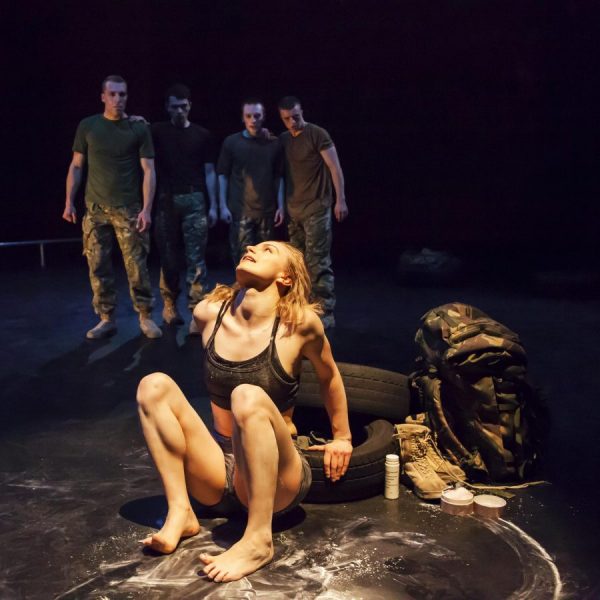@ Tramway, Glasgow, until Sun 30 Apr 2016 (and touring)
The Body is the Frontline.
5 Soldiers, presented by Rosie Kay Dance Company, is an incredibly well-considered piece that draws fascinating parallels between Army service and professional dance, more often considered to be polar opposites. By focusing on the bodies of its soldiers, the work effectively conveys how it feels to serve in the Army, while asking provocatively how art might collaborate with societies and cultures that have different perspectives, motivations and experiences.
Detailing the experiences of five members of the armed forces, 5 Soldiers follows the narrative arc—or dramaturgy—of military conflict. The show begins with a long period of preparation: a series of training drills. Director and choreographer Rosie Kay and dramaturg Ben Payne, use these exercises to emphasise the close relationships that both dance and military service have with human bodies: both require training and incredible persistence.
Whether it is in the physical exhaustion that Duncan Anderson, Luke Bradshaw, Reece Causton, Shelley Eva Haden and Oliver Russell continually push their bodies towards, or the monotonous repetition of everyday tasks, such as lace-tying and teeth-brushing, 5 Soldiers uses the movement of bodies to make how it might feel to serve in the Army tangible: day by day, moment to moment.
Annie Maharani’s composition is integral to this process of humanising these soldiers to the audience, and establishing a common ground. Long drones foreground the everyday monotony of life in the military, and the punctuation of pop-hits stresses the contingency between the worlds of the “military” and the “civilian”—both audience members and soldiers listen and move to Katy Perry.
When the combat does finally arrive, the gunshots permeate the space like whispers, drowned out by the stamping of boots and the thunderous rhythm of breath. Again the focus returns to the bodies. The result is an experience that is kinetic, frantic and deeply affecting. The subtleties of Maharani’s soundscape, are far more evocative of how combat might be experienced than the spectacular depictions of war found in Hollywood blockbusters. The audience feels every blow and breathes every breath.
When turning to the aftermath of conflict, 5 Soldiers becomes harrowing, the lights descend as a young man adjusts to being amputated below both knees. At its close, the piece resists falling into narratives of triumphalism, of the bodily sacrifice being ultimately heroic. Instead, this disablement is portrayed as an extremely difficult period of adjustment, one that is severely distressing, and, of course, long-lasting. As the soldier discovers his new quality of movement, taking note of his changed centre of gravity, the consequences of conflict are clear, as are the longevity of the sacrifices made by members of the armed forces.
The work is presented in association with the Army, who have provided funding and other means of support. Despite this influence, 5 Soldiers never feels like an exercise in public relations, but instead scrutinises military life and culture. Of the five soldiers, one is female, and her place within the group is made complicated by this fact. At times she is subject to the lustful gazes and predatory approaches of her fellow soldiers, culminating in a rape. Moments later, she appears at ease, fighting alongside her fellow soldiers.
Kay allows these uncomfortable moments to juxtapose, exposing this culture for the audience to observe, and does not close-off these observations by attempting to resolve these issues on stage. During these moments, 5 Soldiers is profoundly uncomfortable to watch, and pulls no punches in its attempts to confront its audience with the realities of military life.
